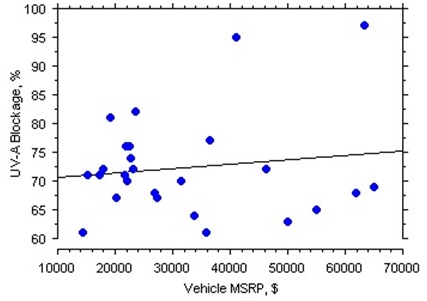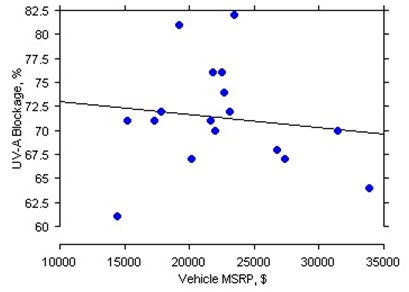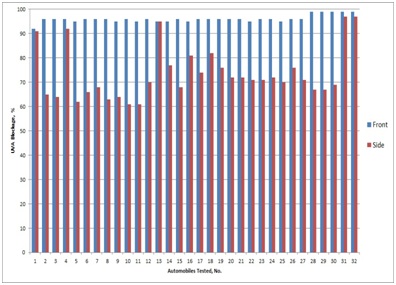
Correlation of Side Window Ultraviolet A Radiation Protection with Price of Newer Automobiles
*Corresponding Author(s):
Brian S Boxer WachlerBoxer Wachler Vision Institute, 465 N. Roxbury Drive, Suite 902, Beverly Hills, CA, United States
Tel:+1 3108601900,
Email:bbw@boxerwachler.com
Abstract
Objective: To correlate the level of UVA light protection in automobile side windows with vehicle price and assess protection in newer automobile side windows and windshields.
Design: Cross sectional study; Thirty two cars from 21 car manufacturers were analyzed in this cross-sectional study. Outside ambient UVA radiation was measured along with UVA radiation behind the front windshield and behind the driver side window of all cars. The years of the cars ranged from 2014 to 2016.
Setting: Car dealerships in Los Angeles, California
Participants: Automobiles
Main Outcome and Measure: Amount of UVA blockage from windshields and side windows.
Results: Regression analysis between side window protection and vehicle year of manufacturer was r2 = .04 (p=0.75). The average front windshield UVA blockage was 96%, range 92% to 99% (95% CI, 95.7%-96.3%) was higher than side window blockage which was 73%, range 61% to 97% (95% CI, 66.4%-75.6%). The difference between front windshield and side window UVA blockage was 23%. A high level of side window UVA blockage > 90% was found in 5 of 32 cars (15.6%).
Conclusion & Relevance: Side window UVA protection was highly variable and did not correlate with cost of automobile. Front windshield UVA protection was consistently high among cars. These results may in part explain the reported increased rates of cataract in left eyes and left-sided facial skin cancer. Automakers may wish to consider increasing the degree of UVA protection in vehicle side windows in all vehicles regardless of sales price.
Keywords
INTRODUCTION
Newer automobiles are often more technologically advanced than older automobiles including safety features. More expensive vehicles typically include more options compared to lower end vehicles. We performed this study to assess if there was a correlation with UVA light protection of side windows cost of vehicle as well as to assess the degree of UVA light protection in newer automobiles.
EXPERIMENT/MATERIALS AND METHODS
The percentage of UVA blockage for each car’s front windshield and driver side window was calculated by subtracting the UVA energy measured behind the window from the outside UVA energy. That figure was divided by the outside UVA energy. This fraction was converted to percentage by multiplying 100. Paired t-test was used to compare UVA blockage of front windshields and side windows and simple linear regression analysis was performed using two variables: Side window protection (dependent variable) and vehicle year (Stat view, SAS, Cary, NC) in order to assess if older cars had lower UVA protection as a possible result of aging UVA window films. Cost data was found on manufacturer’s website to determine new vehicle cost.
RESULTS
Table 1 displays the cars analyzed in our study with the UVA measurements and percentages of UVA blockage. Figure 1 shows there was no correlation of vehicle cost and side window UVA protection (r2= 0.10, P= 0.07). For 26 cars with MSRP (Manufacturer’s Suggested Retail Price) under $70,000 there was also no correlation of vehicle cost and side window UVA protection (r2= 0.02, P= 0.50) (Figure 2). Figure 3 shows for 17 cars with MSRP under $35,000 there was also no correlation of vehicle cost and side window UVA protection (r2= 0.02, P= 0.62). Figure 4 shows the distribution of front windshield UVA blockage and the more variable distribution of side window UVA blockage for same vehicles.


Figure 2: Distribution of 26 cars with MSRP under $70,000.

Figure 3: Distribution of 17 cars with MSRP under $35,000.

Figure 4: The distribution of front windshield UVA blockage compared to distribution of side window UVA blockage for same vehicles.
|
Car |
Year |
Model |
Outside |
Front |
Side |
blocked |
|
Blocked |
Blocked |
Vehicle MSRP |
|
|
|
|
|
|
|
Front |
Side Blocked |
Front % |
Side % |
|
||
|
|
|
(milliwatt/cm2) |
(milliwatt/cm2) |
(milliwatt/cm2) |
(milliwatt/cm2) |
(milliwatt/cm2) |
|||||
|
Rolls Royce |
2014 |
Phantom Drophead |
2.69 |
0.21 |
0.25 |
2.48 |
2.44 |
92% |
91% |
$440,825 |
|
|
Chevrolet |
2015 |
Corvette Stingray |
2.8 |
0.11 |
0.98 |
2.69 |
1.82 |
96% |
65% |
$55,000 |
|
|
Ferrari |
2014 |
California |
2.8 |
0.12 |
1.01 |
2.68 |
1.79 |
96% |
64% |
$198,190 |
|
|
Mercedes |
2015 |
ML63 AMG |
2.6 |
0.11 |
0.22 |
2.49 |
2.38 |
96% |
92% |
$112,140 |
|
|
Ferrari |
2015 |
California T |
2.8 |
0.13 |
1.06 |
2.67 |
1.74 |
95% |
62% |
$198,973 |
|
|
Lamborghini |
2015 |
Huracan |
3.19 |
0.13 |
1.09 |
3.06 |
2.1 |
96% |
66% |
$237,250 |
|
|
Lincoln |
2015 |
Navigator |
2.81 |
0.1 |
0.89 |
2.71 |
1.92 |
96% |
68% |
$61,920 |
|
|
BMW |
2015 |
528i sedan |
2.75 |
0.1 |
1.02 |
2.65 |
1.73 |
96% |
63% |
$49,950 |
|
|
BMW |
2015 |
M235i coupe |
2.71 |
0.13 |
0.97 |
2.58 |
1.74 |
95% |
64% |
$33,845 |
|
|
Ford |
2015 |
Fiesta |
2.53 |
0.11 |
0.98 |
2.42 |
1.55 |
96% |
61% |
$14,455 |
|
|
Volvo |
2015 |
XC60 T5 |
2.76 |
0.15 |
1.07 |
2.61 |
1.69 |
95% |
61% |
$35,750 |
|
|
Acura |
2015 |
TLX |
2.69 |
0.11 |
0.8 |
2.58 |
1.89 |
96% |
70% |
$31,445 |
|
|
Lexus |
2015 |
RX350 |
2.6 |
0.12 |
0.12 |
2.48 |
2.48 |
95% |
95% |
$40,970 |
|
|
Lexus |
2015 |
IS250 9502E |
2.63 |
0.14 |
0.6 |
2.49 |
2.03 |
95% |
77% |
$36,550 |
|
|
Toyota |
2015 |
Camry LE |
2.69 |
0.12 |
0.86 |
2.57 |
1.83 |
96% |
68% |
$26,790 |
|
|
Scion |
2015 |
tC |
2.62 |
0.14 |
0.5 |
2.48 |
2.12 |
95% |
81% |
$19,210 |
|
|
Honda |
2015 |
Civic EX-L |
2.76 |
0.12 |
0.73 |
2.64 |
2.03 |
96% |
74% |
$22,640 |
|
|
Honda |
2015 |
CR-V |
2.76 |
0.11 |
0.5 |
2.65 |
2.26 |
96% |
82% |
$23,445 |
|
|
Chevrolet |
2015 |
Malibu |
2.78 |
0.12 |
0.68 |
2.66 |
2.1 |
96% |
76% |
$22,465 |
|
|
Chevrolet |
2015 |
Tahoe |
2.72 |
0.11 |
0.75 |
2.61 |
1.97 |
96% |
72% |
$46,300 |
|
|
Chevrolet |
2016 |
Cruze LS |
2.57 |
0.09 |
0.73 |
2.48 |
1.84 |
96% |
72% |
$17,845 |
|
|
Hyundai |
2016 |
Elantra SE |
2.51 |
0.13 |
0.74 |
2.38 |
1.77 |
95% |
71% |
$17,250 |
|
|
Hyundai |
2015 |
Elantra Sport |
2.54 |
0.11 |
0.74 |
2.43 |
1.8 |
96% |
71% |
$21,600 |
|
|
Jeep |
2015 |
Cherokee |
2.47 |
0.1 |
0.68 |
2.37 |
1.79 |
96% |
72% |
$23,095 |
|
|
Chrysler |
2015 |
200 |
2.5 |
0.12 |
0.74 |
2.38 |
1.76 |
95% |
70% |
$21,995 |
|
|
Kia |
2015 |
Optima LX |
2.45 |
0.1 |
0.6 |
2.35 |
1.85 |
96% |
76% |
$21,840 |
|
|
Kia |
2015 |
Soul + |
2.45 |
0.09 |
0.7 |
2.36 |
1.75 |
96% |
71% |
$15,190 |
|
|
VW |
2015 |
Beetle |
3.31 |
0.04 |
1.09 |
3.27 |
2.22 |
99% |
67% |
$20,195 |
|
|
VW |
2015 |
Golf TSI 2 door |
3.28 |
0.04 |
1.09 |
3.24 |
2.19 |
99% |
67% |
$27,395 |
|
|
Jaguar |
2016 |
F-type |
3.64 |
0.04 |
1.14 |
3.6 |
2.5 |
99% |
69% |
$65,000 |
|
|
Land Rover |
2015 |
Sport Super Charged |
3.75 |
0.02 |
0.1 |
3.73 |
3.65 |
99% |
97% |
$63,350 |
|
|
Rolls Royce |
2015 |
Wraith |
3.44 |
0.02 |
0.1 |
3.42 |
3.34 |
99% |
97% |
$294,025 |
|
DISCUSSION
This study found that there was no correlation between cost of vehicle and degree of driver’s side window UVA protection. In other words, more expensive vehicles did not predictably provide greater UVA protection to drivers. Therefore consumers who purchase more costly cars should be aware that higher vehicle cost does not guarantee full UVA side window protection. Of the luxury models in table 1, Rolls Royce provided high UVA side window protection (91% and 97%) whereas Ferrari (64% and 62%) and Lamborghini (66%) were among the lowest of all cars in this study. The side window protection of a number of less expensive vehicles (while inadequate) such as Chevrolet, Hyundai, Scion, Toyota, Honda, Kia and VW were higher than some luxury cars such as BMW, Ferrari and Lamborghini.
As in my previous study [1], front windshields offered consistent protection for driver’s eyes and faces against harmful effects of UVA light because of plastic within the windshield that provides UVA protection. Even in newer cars side windows on average had poor UVA protection. There was a large gap between windshield and driver’s side window protection in newer cars as indicated by only 15.6% of cars had a high level (>90%) of side window UVA protection. Additionally a number of cars had a factory window tint on the side windows, but it did not guarantee increased UVA blockage.
There are limits to our study. While the number of models tested in this study were expanded from my previous study, all makes and models were not evaluated. It is unknown that the degree of side window UVA protection is in makes and models not in this study.
This study found that there was no correlation in subject car’s side window UVA protection with vehicle cost. This UVA exposure may increase the risk of cataract and skin cancer. Front windshields were found to have a high degree of UVA protection. It is prudent for drivers to reduce the UVA exposure by 1) Wearing sun block 2) Wearing sunglasses with a wraparound frame design and 3) Consider having a clear aftermarket UVA-blocking film added to their side windows. Automobile manufacturers may consider increasing the UVA protection of side windows to equal that of front windshields.
REFERENCES
- Boxer Wachler BS (2016) Assessment of levels of Ultraviolet A light protection in automobile windshields and side windows. JAMA Ophthalmol 134: 772-775.
- Chylack LT Jr. (1984) Mechanisms of senile cataract formation. Ophthalmology 91: 596-602.
- Chang C, Murzaku EC, Penn L, Abbasi NR, Davis PD, et al. (2014) More skin, more sun, more tan, more melanoma. Am J Public Health 104: 92-99.
- Butler ST, Fosko SW (2010) Increased prevalence of left-sided skin cancers. J Am Acad Dermatol 63: 1006-1010.
- Paulson KG, Iyer JG, Nghiem P (2011) Asymmetric lateral distribution of melanoma and Merkel cell carcinoma in the United States. J Am Acad Dermatol 65: 35-39.
- Hirvela H, Luukinen H, Laatikainen L (1995) Prevalence and risk factors of lens opacities in the elderly in Finland. A population-based study. Ophthalmology 102: 108-117.
- Abraham AG, Cox C, West S (2010) The differential effect of ultraviolet light exposure on cataract rate across regions of the lens. Invest Ophthalmol Vis Sci 51: 3919-3923.
- Foley P, Lanzer D, Marks R (1986) Are solar keratosis more common on the driver’s side? Br Med J (Clin Res Ed) 293: 18.
Citation: Wachler BSB, Wachler MB (2018) Correlation of Side Window Ultraviolet A Radiation Protection with Price of Newer Automobiles. J Ophthalmic Clin Res 5: 38.
Copyright: © 2018 Brian S Boxer Wachler, et al. This is an open-access article distributed under the terms of the Creative Commons Attribution License, which permits unrestricted use, distribution, and reproduction in any medium, provided the original author and source are credited.

